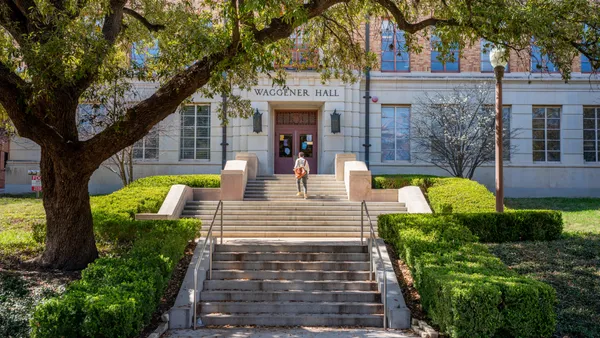Dive Brief:
- Lou Pugliese, senior innovation fellow and managing director for the Technology Innovation Action Lab at Arizona State University, and Kate Smith, vice president of academic affairs at Rio Salado College, spoke during a panel discussion at the Council for Higher Education Accreditation Annual Conference in Washington, D.C. this week about developing and quantifying returns for effective online education. They revealed four conclusions of an extensive research project on the topic: take a strategic portfolio approach to digital learning; build capabilities and expertise to design for quality in the digital realm; provide the differential student support to succeed in fully online learning; and engage faculty as true partners, equipping them for success.
- The research project, which is run by ASU's Action Lab, in conjunction with Boston Consulting Group and initiated by the Bill & Melinda Gates Foundation, came to these conclusions by looking at the characteristics of digital learning programs from six diverse institutions: Kentucky Community & Technical College System, the University of Central Florida, Georgia State University, Houston Community College, Rio Salado College and ASU. The report offers case studies of these universities and colleges and a synopsis of research on economically and operationally efficient points of comparison for other institutions dabbling in online education.
- Smith and Pugliese offered insight into the online learning models of their institutions to discuss some of the key aspects of the ASU report that focuses on three main components, including defining what return on investment in digital learning formats really means and developing common shared metrics for the industry to create benchmarks of comparison.
Dive Insight:
The ASU report also assessed the impact of a variety of online learning formats, and looked at the implementation factors that make programs work at scale. The report includes case studies that the Action Lab team determined are six exemplar institutions in the digital learning field, with analysis of those models for institutions to learn from.
"This is a particularly timely subject, because we've been around for 20 years in online ... and it hasn't been until the last six to eight years or so it's really developed this level of competency where institutions are taking full advantage of creating a digital medium to reach new populations that we are no trying to serve," explained Pugliese.
During the panel session, Smith offered insight into her institution, Rio Salado College, within the context of the report. She explained Rio Salado kept costs down while scaling its digital learning platform by using adjunct faculty for online classes and compensating them from a step-function paradigm, where teachers are paid per enrollee. Smith said this type of practice involves more than 1,500 adjunct faculty members with limited course-design input, and 23 full-time faculty chairs crafting courses to help adjuncts learn the best ways of delivering the content, creating and accessing open educational resources and spearheading curriculum.
Though members of the audience raised concerns about faculty buy-in and whether that would impact the quality of instruction, Smith explained Rio Salado boasts an over 90% faculty retention rate by conducting constant staff meetings, creating manageable standards for student interactions, and having consistent feedback metrics, among other quality assurance practices.
"Those mini-evaluations take place throughout, and our faculty chairs develop really strong relationships with adjuncts. We listen to our adjuncts, they are partners in the work we do, we have many that are hired as leads or subject-matter experts," said Smith. She mentioned every adjunct faculty member makes a video for their students to build the connection.
Pugliese offered insight into ASU's model, remarking that the institution's online programs focus on student outcomes, increasing access to all kinds of students — in particular a growing body of non-traditional learners — creating measures for boosting enrollments, working around physical scheduling constraints of faculty and students, optimizing instructional costs, and enhancing the innovation reputation of the institution.
Pugliese drove home the fact that ASU, in developing its online presence, invested in an in-house team of design experts and only outsourced two aspects of the program to third parties, noting Pearson provides student acquisition support, while Blackboard provides the learning management system. He said one key driver of success has been investment in data analytics, noting he and his team of researchers at Action Lab work closely with the digital design team to study what students engage with and what can be improved through instructional design modality.
"We have roughly 45 to 50 instructional designers full time, and their role is to really work with faculty to present the technology and the design expertise they may not have," he said. "What we are doing, given limited flexibility in learning management systems, is deconstructing these types of technologies and creating plug-ins and different ways to shape the learning experiences."











